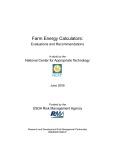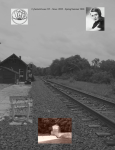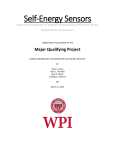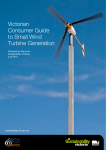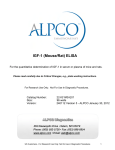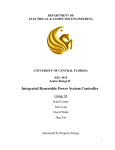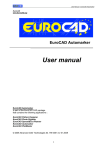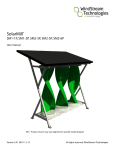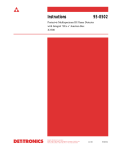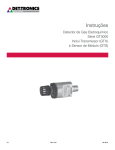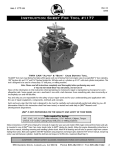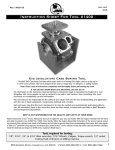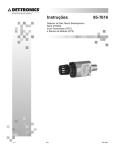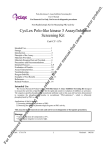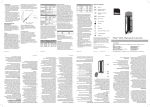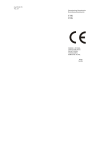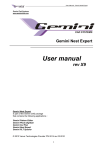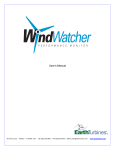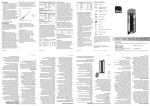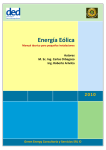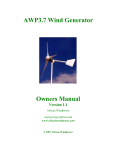Download the full report (pdf – 472k)
Transcript
Small Wind Turbine Purchasing Guide Off-grid, Residential, Farm & Small Business Applications Contents Introduction to Small Wind Turbines...............................................................3 After You Buy: Installation, Operation, and Maintenance.........................12 What is “small wind”?......................................................................................3 Impact of micro-siting on performance expectations.....................................12 Where to go for more detailed planning information......................................5 Getting help with installation.........................................................................12 Before You Buy: Assessing Site-Specific Expectations..............................6 Notifications and compliance with regulations..............................................12 Wind resource and site topography.................................................................6 Safe operation and maintenance requirements.............................................13 Property size, setbacks, and zoning restrictions..............................................7 Permitting Checklist for Small Wind Customers.........................................14 Other considerations: costs, interconnection, neighbours..............................7 Contact your planning department or permitting agency...............................14 When You Buy: Purchase and Permitting.......................................................9 Review the applicable standards and restrictions.........................................14 Sizing your Turbine...........................................................................................9 Communicate with your neighbours...............................................................14 What other equipment will you need?.............................................................9 Plan your purchase and installation...............................................................14 Purchasing tips...............................................................................................10 Environmental review.....................................................................................14 A word about sound levels.............................................................................10 Permitting fees and timetable........................................................................14 Prepare required paperwork...........................................................................11 Glossary..............................................................................................................15 Worksheet – Local Contact & Dealer Information......................................16 This Guide was developed by the Pembina Institute and eFormative Options, LLC with funding from the Canadian Wind Energy Association. The Canadian Wind Energy Association (CanWEA) is a national, not-for-profit association that works on behalf of our members to facilitate and promote the responsible and sustainable growth of wind energy in Canada. Wind energy is an important part of Canada’s energy future, creating new investment and jobs in Canadian communities while also contributing to a cleaner environment for future generations. Established in 1984, CanWEA undertakes policy development and advocacy with different levels of government, implements a broad range of communications and outreach activities and provides educational and networking opportunities for all stakeholders. Contributors included: Heather Rhoads-Weaver, eFormative Options LLC Susan Savitt Schwartz, Editor Kristin Zarowny, Pembina Institute Tim Weis, Pembina Institute Sean Whittaker, CanWEA Meg Gluckman, eFormative Options LLC Michael French, Southwest Windpower Additional project advisors and reviewers included: Mike Bergey, Bergey Windpower David Birch, Lakeshore Power Systems Matthew Bulmer, Aerojoule Brad Davis, Cleanfield Energy Svend de Bruyn, Detronics Ltd. Johan de Leeuw, Wind Energy Solutions Peter Forint, Wardell Professional Development Trudy Forsyth, National Renewable Energy Laboratory Paul Gipe, Wind-Works James Glennie, Wind Energy Institute of Canada Jennifer Jenkins, Southwest Windpower Andy Kruse, Southwest Windpower John Maissan, Leading Edge Projects Miriam Robbins, Southwest Windpower Jennifer Wilder, Canadian Tire Charley Ye, BC Hydro Introduction to Small Wind Turbines For more detailed information about small wind turbines, see the Canadian Wind Energy Association’s small wind webpage at: www.smallwindenergy.ca. Small wind turbines – ranging from “mini” or “micro” battery-charging models under 1 kW to 300 kW tower-mounted turbines – are becoming increasingly accessible through major retail outlets. Consumers interested in the environmental and economic advantages of using . wind power to generate their own electricity want to know: • What benefits can I expect? . What benefits can I expect? How much does a wind turbine cost, and what incentives are available to help pay for it? How much energy will it produce? Will I still need to purchase electricity, have battery storage or install a secondary hybrid solar or micro hydro system? • Is my site appropriate for a small wind turbine? . Can I put a turbine on my property? . What siting requirements or restrictions will . I need to consider? • Which turbine is best for me? . What size turbine do I need? . What other equipment do I need to purchase? • How can I get my turbine installation approved? . Will I need special permits or other approvals? . What about my neighbours? • Who can help me install my turbine? . What is involved in installing a wind energy system? . Can I do it myself, or will I need to hire someone? • How can I keep my system performing well? . How much maintenance is required? . Do I need additional insurance? . How long can I expect my turbine to last? This Guide is intended to answer these and other questions. It follows a basic “check-list” approach, from evaluating your wind resource and whether your site is suitable for a small wind turbine to choosing the right equipment, obtaining the necessary permits and approvals, selecting an installation contractor, and maintaining and operating your small wind turbine safely. This Guide is organized in three sections: 1.Before You Buy: Assessing Site-Specific Expectations • Wind resource and site topography • Property size, setbacks, and zoning restrictions • Other considerations (costs, interconnection, neighbours) 2. When You Buy: Purchase and Permitting • Sizing your turbine • What other equipment will you need? • Purchasing tips • Preparing documents needed for permitting 3. After You Buy: Installation, Operation, and Maintenance • • • • Impact of micro-siting on performance expectations Getting help with installation Notifications and compliance with regulations Safe operation and maintenance considerations Source: www.windatlas.ca What is “small wind”? Table 1. Small wind applications This guide covers turbines ranging from smaller than 1000 Watts (W) up to 300 kilowatts (kW). Turbine “size” is given in terms of rated capacity: the net level of power (in Watts, or kilowatts) that the turbine is capable of delivering under normal operation. The table below shows the size ranges suited to different “small wind” applications. Market Segment Size Applications <5 kW Pumps/irrigation systems; telecommunications, navigation, area lighting; small remote sites and light seasonal loads* 1-10 kW Residential, small business, heavy seasonal loads Battery charging / Off-grid Residential (grid-connected) Farm / Institutional (grid-connected) >10-300 kW Farm, rural business, institutional * Turbines < 1000 W that are suitable for off-grid recreational applications such as boats and RVs are sometimes referred to as “mini” or “micro” turbines. Figure 1. Examples of different sizes of wind turbines, to scale Total.Height 108.5.m Total.Height 74.8.m Hub Height 70.m Blade Length 38.5.m Total.Height 60.5.m Hub Height 60.m Hub Height 50.m Blade Length 14.8.m Total.Height 38.m Blade Length 10.5.m Hub Height 30.5.m Total.Height 27.4.m Total.Height 21.9.m Hub Height 24.m Hub Height 20m Blade Length 3.4.m Blade Length 1.9.m Blade Length 7.5.m 1.5 MW 100 kW 250 kW 10 kW 50 kW 1.9 kW Total.Height 10.6.m Hub Height 10.m Blade Length 0.6.m 200 Watt Figure 2. Typical Application Sizes Key Markets Remote Communities Farms & Rural businesses On-grid Residential Battery Charging / Off Grid 0.3 kW 1 kW 5 kW 10 kW 30 kW A current listing of small wind turbine manufacturers can be found on CanWEA’s website: . www.smallwindenergy.ca/en/Resources/Manufacturers.html 50 kW 100 kW 300 kW Where to go for more detailed planning information… Buying and installing a wind turbine is a long-term commitment. This guide is intended to: 1) inform your purchase decision with site-specific performance expectations; and 2) supplement installation instructions with “best practice” siting, safety, and interconnection guidelines. CanWEA’s website provides a detailed step-by-step planning guide which includes a tool for estimating the ballpark cost of satisfying your electricity needs with wind energy; detailed information on sizing and siting your turbine; and listings of small wind manufacturers and Canadian dealers and installers. This guide focuses on the elements of the CanWEA planning guide that are marked with an asterisk (*) below. CanWEA’s Small Wind Planning Guide www.smallwindenergy.ca/en/SmallWindAndYou/Planning.html Stage 1: Determining the Ballpark Cost • Given your wind resource and electricity usage, what can you expect to pay for a wind turbine that will meet your needs? Stage 2: Crucial Stuff to Consider • Have you reduced your electricity demand first? • Can you put up a small wind turbine on your property?* • Will your neighbours accept having a wind turbine near them?* • Is your property suitable for putting up a turbine free of obstructions?* • If you need to connect your turbine to the grid, are you allowed and able to do so?* Stage 3: Planning the Rest • What size turbine will satisfy your electrical requirements? • How do you interface with the utility (grid-connected only)?* • Are there any financial incentives to help you pay for your turbine? • Where exactly should you put the turbine on your property?* • What other legal and regulatory issues will you need to address?* • What is the exact wind resource at the proposed turbine location on your site? How can you get a better estimate of a turbine’s technical and financial feasibility? • Is there anything else you should consider before turbine shopping?* • How and where should you buy a turbine and how should it be installed?* Before You Buy: Assessing Site-Specific Expectations • • • Wind resource and site topography Wind resource and site topography Property size, setbacks, and zoning restrictions Other considerations: costs, interconnection, neighbours Location, location, location! The rule of thumb for real estate is also critical for evaluating whether wind energy makes sense for a particular site, and what kind of performance you can expect from a turbine installation. Key site evaluation factors include: Wind energy offers both environmental and economic benefits: it is emissions-free and renewable, and the fuel itself is free, local, and will never fluctuate in cost. But wind systems are a long-term investment, and wind energy is a very site-specific resource. To figure out what benefits you can expect from installing a small wind turbine, you must first evaluate your site – assessing the wind resource, site topography, and relevant permitting restrictions – to determine how much power . you could generate. • Wind speed – Most small turbines require a minimum wind speed of 15 km/hr (4 m/s) or higher just to operate. In general, annual average wind speeds of at least 18 km/hr (5 m/s) are required for grid-connected applications. Note that an average annual wind speed of 22 km/hr (6 m/s) is considered a “moderate” wind resource, but the average wind speed is not always the best indicator of a site’s suitability due to seasonal advantages and application considerations. Wind maps (such as www.windatlas.ca) can give you an approximate idea of whether your area gets enough wind, but local geography may influence whether your site is better or worse than the regional average. A 10% change in wind speed can result in as much as a 30% change in available power, so you may want to monitor wind speeds at the height and location of the specific sites that seem most promising. The financial benefits of a small wind turbine not only depends on how much electricity you can produce, but also on the relative value of that electricity. • Off-grid: If you are looking at a “mini” or other off-grid application, how much power will your application require? • Grid-connected: If you are looking at a system connected to the electric grid, the value of the power you generate is a function of how much you would otherwise expect to pay for utility-generated power. (Check whether your utility allows “net-metering.” This allows your meter to run backward when you produce more electricity than you use, effectively allowing you to “store” excess wind power on the grid and value it at the retail rate.) Putting a turbine on too short a tower is like putting a solar panel in the shade. – Mike Bergey • Minimum land and setback requirements – . Even small turbines need to be mounted on a tower, to . capture higher wind speeds and avoid turbulence from surrounding topography, trees, and other natural and manmade features. Check the local zoning code for minimum property size and setback requirements that may limit your ability to install an appropriate tower for mounting your turbine. The height of the tower, as well as the size of the turbine and the average wind speed, will determine how . much power you can expect to produce. Remember: Saving a kilowatt-hour is almost always cheaper than producing one! Taking steps to reduce your energy use first will save you money and likely reduce the size of the wind turbine you require. Bear in mind that the initial cost can be significant – and that installing and connecting your turbine can cost as much as the turbine itself (see table 2, next page). You will want to consider your objectives, options and potential obstacles before investing. Property size, setbacks, and zoning restrictions Other considerations: costs, interconnection, neighbours Wind energy installations must comply with local building codes, applicable zoning laws and permitting requirements. Check with your local municipal offices for information about requirements and restrictions that may be relevant to your installation, including: minimum lot or property size, required setbacks from property lines or neighbouring structures, height restrictions, and noise ordinances. Find out ahead of time what approvals you may need. (See the “Permitting Checklist” included at the end of this Guide.) How much will it cost to purchase and install a wind system? System cost is partly a function of size, but in addition to the cost of the turbine, tower and foundation, your budget must take into account permits and fees, installation costs (including mechanical, electrical, and civil services), and maintenance costs. For example, the average purchase cost of a 10 kW residential turbine is $30,000-40,000 – but the total installed cost is usually double that amount (see table 2, below). While a turbine’s installed cost per rated kW is an important consideration, its performance in your wind regime is the biggest factor in the resulting cost of electricity produced. Depending on your terrain and soil conditions, a special foundation design, a taller than standard tower, and/or various installation installations may add costs. Comparing turbines on an expected price per kWh basis is a good way to incorporate many of the variables as well as to determine if you are being appropriately compensated for the renewable electricity you are delivering to the grid. • Height restrictions: “The taller the tower, the better the power” is an old adage from the 1930s, and it is no less true today. The height of the turbine tower is a key factor determining the operational efficiency of the turbine because wind speeds generally increase with height above ground (with wind energy increasing exponentially as a function of wind speed), and because there should be sufficient clearance between the lowest tip of the turbine blade and any nearby natural or man-made structure to minimize local air turbulence. Zoning restrictions on your site may limit the allowable tower height, requiring you to seek a conditional use permit or variance from your city or county planning department. Local authorities have the discretion to issue zoning waivers for small turbines where appropriate. • Setback requirements: Generally, turbines should be set back at least by the height of the tallest point on the turbine from all buildings, electrical lines, roads and property lines (unless specific permission is granted from your neighbour). Specific local zoning restrictions may include other setback requirements, notably for noise requirements. Building a system from off-the-shelf components may appear to offer savings over turn-key systems, but there may be a trade-off in terms of efficiency losses, and it is risky to install and may be impossible to obtain permits and interconnection approval for equipment (including towers) that has not been certified. CanWEA has a “Ballpark Cost Calculator” that looks up the wind performance and electricity rates for your postal code and examines how four typical turbine sizes (400 W, 1 kW, 10 kW, and 50 kW) might be expected to perform in your area. www.smallwindenergy.ca/en/ SmallWindAndYou/Planning/BallparkCost.html Table 2: Average Capital & Installed Costs* for Small Wind Turbines Small Wind Typical Turbine Power Applications Rating Average Purchase Average Total Cost* of Turbine Only Installed Cost* (per unit power) (per unit power) Battery Charging Up to 1,000 W (1 kW) $2,800-3,000/kW $5,000-$7,000/kW Residential 1 kW to 10 kW $3,000-4,000/kW $6,000-8,000/kW Farm Above 10 kW $2,000-$2,500/kW to 300 kW $3,000-4,000/kW * Costs are based on a 2004 survey of Canadian pricing estimates and reflect the average of a range of installations that may vary depending on technology, location and other site specific factors. Note that prices based on manufacturers rated power do not necessarily provide comparable resulting costs for energy production at a given wind speed. For up-to-date cost estimates, consult a reputable dealer or check the CanWEA website: www. smallwindenergy.ca/en/Overview/Costs/CostComparison.html Incentives can be found at the federal, provincial, local, or utility level. Consult your local utility or check the CanWEA website for up-to-date information about available incentives. Annual operation and maintenance costs typically range around 3% of the initial capital cost (including installation) for a well-designed and well-built turbine. 1 Connecting to the Grid Unless you are planning a “micro” turbine application or an off-grid application, you will need to review the requirements for connecting your turbine to the local utility grid. You should also contact your local utility to find out whether they offer a “net billing” or “net metering” arrangement. Let your neighbours know your plans The courtesy of informing neighboring property owners about your system installation can correct misperceptions and avert opposition to your project. A letter like the one included below will answer most questions people have about wind turbines – how much sound they produce, the visual impact, safety considerations, and potential affects on wildlife and property values. It can let neighboring property owners know that you have done your homework and are proceeding responsibly. Dear Neighbour, You may be interested to learn that we plan to install a small wind energy system on our property at [address]. This modern system will generate emission-free renewable electricity that will reduce use of other forms of energy. We plan to install a [turbine make and model] that will be mounted on a __m tower, set back ___ m from the street and __ m from our [north/east/south/west] property line. This turbine uses a [two/three] bladed rotor ___ m in diameter. It does not turn until the wind speed reaches at least __ kph. On calm, quiet days the turbine will not likely be audible. When the rotor is turning, the sound of the wind passing through will register about __ decibels (dBA) at a distance of __ m, which will barely be audible from neighboring buildings over other sounds caused by the wind. [Manufacturer] has installed [number] of [turbine make and model] in Canada [and overseas]. They have a track record of producing energy quietly, cleanly, and safely. If you have any questions about the proposed installation, please feel free to contact me. Sincerely, Natural Resources Canada 1 When You Buy: Purchase and Permitting • • • • • What other equipment will you need? Sizing your turbine What other equipment will you need? Purchasing tips A word about sound levels Prepare required paperwork Small wind turbines typically consist of: a 2-3 bladed rotor, a generator (DC) or alternator (AC) that converts wind energy into electric power, the gearbox (that matches the rotor speed to the generator speed for some turbines > 10 kW), the nacelle (which houses the generator, gearbox and other components), the tail vane, and the control and protection system. Other less common designs include vertical axis and multi-bladed turbines. The rotor and nacelle should be mounted on a tall tower, which positions the turbine where it can capture the wind energy and avoid turbulence. Finally, there are “balance of system” (BOS) components which may include batteries and an inverter, along with cables, switches, circuit breakers, meters, and other apparatus not necessarily supplied by the turbine manufacturer. Sizing your turbine The size of the turbine you require depends on your wind resource and how much power you need to generate. Manufacturers typically provide a power curve or energy curve indicating the turbine’s expected power output or energy production at various wind speeds. Note that power curves are not standardized and only provide an approximation of how much electricity a turbine will generate. In general, the larger the “rotorswept area” (the diameter of the circle defined by the rotating blades), the more power a turbine will produce at a given wind speed. “Let the Buyer Beware...” …is sound advice when purchasing a small wind turbine. Remember, if it seems too good to be true, it probably is! Check the performance track record for the turbine make and model before you buy, and purchase only from an authorized dealer. • Multiply your annual electricity consumption in kilowatt-hours (kWh) by the percentage you want to satisfy with small wind to determine the annual kWh you need the turbine to satisfy. • Take your site’s average annual wind speed and look at the manufacturer’s specifications for each turbine to get an idea of approximately how much power the turbine would produce. Compare the generating performance of each model with your peak power needs and the annual electricity you want the turbine to generate for you. • Consider the specific types of equipment you wish to power and your utility’s interconnection requirements. What quality of AC power does the inverter produce? Is it capable of meeting your needs? Because the wind is a variable resource, you may need to consider secondary power options. Off-grid systems typically include battery storage, but you may want to consider other sources of generation, such as a biodiesel generator or even a hybrid system combining wind with solar power or micro hydro. Grid-connected systems give you the option of drawing power from the grid as back-up when your wind turbine does not meet your power needs, allowing owners to “net meter” the turbine’s production against on-site usage. Monthly Energy Output (kWh) Figure 3. Representitive Energy Curve for 200 watt Wind Turbine 60 50 40 30 20 10 0 8 (3.6) 9 (4.0) 10 (4.4) 11 (4.9) 12 (5.4) 13 (5.8) 14 (6.3) Average Annual Wind Speed Purchasing tips For UL certification the inverter must be tested to standards to ensure safety. We recommend this because utility companies have a higher degree of confidence that their electrical line workers won’t be hurt by wind turbines. Comparison shop for a wind system as you would for any major purchase – start by obtaining and reviewing the product literature from several manufacturers. Check ratings from the North American Small Wind Certification Council, if available. Here are some questions to consider when choosing a brand and model: — Trudy Forsyth • Performance track record: How long has the manufacturer been producing small wind turbines? How long has the make and model been on the market, and what is its track record for performance and longevity at customer installations? Is your site’s average wind speed well above the cut-in, or minimum required for the turbine to start generating power? Can the turbine’s overspeed protection be demonstrated to be effective? How quietly does the turbine operate? • Components: Do you need to buy the tower, electronics, and other components separately or are they all included? Are the wiring and smaller parts also supplied? Do all the components have UL and CSA approval? Is there sufficient lightning protection? Does the warranty cover a reasonable period including documented repair service on both parts and labour, as well as crane costs if needed? • Services: What services are offered with the turbine (e.g., installation assistance, maintenance package)? Does the manufacturer offer any technical support? • Installation and Maintenance: Is the turbine suitable for do-it-yourself installation, or will you need a professional to install it? (See”getting help” on page 12.) How easy will it be to get replacement parts now and in 10-15 years? • Documentation: Can you browse the user manual before buying? Does the manual clearly describe the assembly and installation procedures for the unit and the subsequent operation and maintenance requirements? CanWEA’s website lists 35 small wind turbine manufacturers (worldwide) and 150 Canadian dealers and installers. Dealers have to be authorized by the manufacturer. Once you have narrowed down your choice of model, compare what different dealers have to offer. Is the model available locally? Is it popular enough that you might be able to find a better deal on it from a different dealer? Does the dealer offer installation services and have a good reputation? Be sure to ask for – and check – references and insurance policies! Inquire with your local chamber of commerce about any complaints and make sure the company you select has not been sued or cited for fraudulent business practices. A word about sound levels In most cases, the sounds wind turbines make when operating generally blend in with background noise from cars, animals, airplanes, and trees in windy conditions. Within a few hundred meters of a machine, it may be possible to distinguish the “swish” sound of its turning blades and the whirring of the generator from background noise. However, the actual noise level depends on the turbine itself, the wind pattern (turbulent wind increases noise), the site terrain (sound travels farther . in certain terrains), and the distance to dwellings. Complaints (from customers or others) about sound characteristics are rare, but are usually related to turbines with flexible blades and side furling mechanisms. The sound strength right at the base of the wind turbine (sound power level) varies from about 75-100 dB(A), which at a distance of 30 m (100 ft) from the rotor hub corresponds to sound pressure levels (perceived sound) of 40-65 dB(A). For comparison, . 40 dB(A) is roughly equivalent to the sound level in an average living room; the average office is about 50 dB(A), and a loud conversation is . 60 dB(A). In a typical Class 3 wind regime with wind speeds averaging 5.6 m/s (12.5 mph), most commercially available small-scale wind turbines will produce sound pressure levels exceeding 65 dB(A) about 6% of the time, at wind speeds above 11 m/s (24 mph). What the warranty really covers should be considered, but in our experience even a 5-year warranty is not a measure of a unit’s quality. Replacing a $5 bearing after returning the unit to the factory falls far short of the full repair cost. — Svend de Bruyn Rule-of-thumb: The mean sound pressure level value should not exceed 6 decibels (dBA) above background sound, as measured at the exterior of the closest neighbouring inhabited dwelling (for wind speeds >10 m/s). 10 Sound levels decrease at a rate equal to the square of the distance . from the source. A sound reading taken 7.6 m (25 ft) from a turbine . will fall by a factor of four at 15 m (50 ft), by a factor of 16 at . 30 m (100 ft), and so on. If the turbine is well sited, then noise is not usually a problem. Because some small turbines can be noisier than others, it is critical to do your homework (preferably by obtaining data and case studies from the dealer and/or manufacturer) on the make . and model you plan to install, find out what distance you need to set it back from nearby buildings, and discuss noise issues with your neighbours before purchasing and installing a turbine. Prepare required paperwork Do your homework. Find out what documentation your municipal permitting authority and local utility require. Will you need to submit plans from a consulting engineer? Or will documentation from the turbine manufacturer or dealer suffice? At a minimum, you will need to demonstrate that your project complies with the applicable: • Building code: The turbine manufacturer should provide documentation of International Building Code compliance. • Electric code: You will need a line drawing showing conformance with existing electrical codes and applicable authority (e.g. Electrical Safety Authority in Ontario). If you need to seek a conditional use permit (CUP) or a waiver from local zoning restrictions to accommodate the height of your tower, check with your city or county planning department as to what documentation . they require. 11 After You Buy: Installation, Operation, and Maintenance Getting help with your installation • Impact of micro-siting on performance expectations • Getting help with installation •Notifications and compliance with regulations • Safe operation and maintenance considerations Unless you are installing a very small turbine or are very . experienced and knowledgeable about the technology, you should seek professional assistance with installing your turbine. CanWEA recommends that you obtain quotes from a minimum of three installers. . See CanWEA’s website for a list of small wind dealers and installers . (www.smallwindenergy.ca/en/Resources/DealersInstallers.html). Impact of micro-siting on performance expectations Within a site, the ideal turbine position is where wind is least obstructed – often the highest point on the site. At a minimum, wind turbines should be elevated high enough to avoid air turbulence that places stress on mechanical components and compromises turbine performance (see “Rule of thumb” below). Manufacturers always recommend elevating the turbine well above adjacent obstacles. Rule of thumb: To optimize peformance, the bottom tips of the turbine blades should pass at least three (3) times above the top of any physical barriers (trees, buildings, bluffs) within 90150 m of the wind turbine tower. Generally can be installed by the user and requires very little maintenance.* >500 W-1 kW Can be installed and maintaned either by a know- ledgeable owner or by an experienced professional. > 1 kW Will almost always require professional installation and maintenance. Notifications and compliance with regulations Your small wind turbine requires the notification of and/or approval from Transport Canada, local permitting agencies, and (in the case of grid-connected turbines) your local utility. A professional installer may be able to help you obtain the necessary permits, but notification and compliance with relevant zoning, building and electrical codes, air traffic safety requirements, and utility interconnection requirements are ultimately your responsibility. — Mick Sagrillo Figure 4. Obstruction of the Wind Apply for permits Once you have the necessary documentation ready, you can apply for a building permit if required. Processing small wind turbine permit applications can take up to six weeks or more from the time the permit and all required documentation are filed, so find out what you will need early on. The Canadian Wind Energy Association (CanWEA) has prepared a guide to siting small wind energy systems that includes detailed checklists and additional “best practice” guidelines for consumers and installers. This guide can be downloaded from CanWEA’s website: www. smallwindenergy.ca/downloads/Small_Wind_Siting_Guidelines.pdf ? Region of highly turbulent flow 2H 20 H 02979307m Obstruction of the Wind by a Building or Tree of Height (H) 2H < 500 W Installers should provide a warranty on installation and be able to confirm their liability insurance. Electrical components should be installed or inspected by a contractor qualified by the provincial or territorial electrical authority – e.g., the Electrical Safety Authority in Ontario. A professional installer should be able to help with obtaining the necessary permits and approvals. Be sure to check prospective installers’ experience and references (see Installer evaluation worksheet included at the end of this guide). The three most common errors in siting a wind turbine: Too low a tower Too short a tower Tower of insufficient height Can I install it myself? * It is not a good idea to mount a turbine on a roof or attach it to a building without the advice of a competent structural engineer. Tower-mounted horizontal axis wind turbines (HAWTs) generally perform much better than vertical axis wind turbines (VAWTs), and account for the vast majority of small wind turbine installations. Bear in mind that rooftop installations can be dangerous, and in rare cases where feasible require careful analysis by expert structural engineer as to the impact on the building’s structure. 1. 2. 3. Turbine Size 12 Are you willing to “check the oil” and keep up the wind turbine’s maintenance as required? If not, don’t install one! A note about fees: CanWEA recommends that small wind permit fees not exceed $50. If a particular fee seems excessive or inappropriate for your situation, find out the basis for it. You may be able to avoid it or have it reduced. - David Birch Notify electric utility (grid-connected systems only) Grid-connected system owners will need to notify the local electric utility, secure an interconnection agreement with host utility, and schedule inspections before interconnecting the turbine with the grid. The utility’s interconnection requirements serve to ensure the safety of personnel and equipment as well as the quality of power being fed into the utility grid. While smaller machines need very little intervention during operation and very minimal maintenance until replacement, wind expert Paul Gipe cautions that small turbines seldom last as long or are as trouble-free as advertised. More complex designs and larger machines require regular maintenance and a major component replacement after 10-15 years. Off-grid systems with batteries require: Notify Transport Canada • Keeping the batteries within operating temperature ranges • Ensuring charge and discharge rates are not exceeded • Using correct switches, fuses and circuit breakers to help ensure safe operation • Maintaining unsealed lead-acid batteries, topping up of water and verifying state of charge • Storing batteries in ventilated enclosures due to off-gassing. Transport Canada requires that prospective owners accurately provide the location (latitude and longitude) and height of all wind turbines to be installed so that they can be plotted for aeronautical maps and flight paths. Navigation Canada may then impose specific markings and lighting that must appear on the turbines so that helicopters and airplanes in both commercial pathways and search and rescue zones can visually identify the wind turbines. Insurance & safety recommendations Keep your neighbours apprised Insurance: Many homeowner insurance policies can be extended to insure against a liability brought about by damage or injury caused by a wind turbine. The wind turbine itself can be protected by insurance coverage against damage as a result of fire, lightning, ice or theft. Check with your agent for specifics. If you have not already notified your neighbours, this is a good time to do it. Taking steps to show that you have done your homework and providing information ahead of time is both a courtesy and the best way to avert opposition. Safe operation and maintenance requirements Safety: To minimize the likelihood of damage or injury, consider reserving a set-back distance of at least one tower height from property lines and structures, and including an anti-climb device on the wind turbine tower. Other recommendations: A turbine is much like a car: it must be operated safely, and requires regular attention and care to work properly. But because it is mounted . on a tall tower, reliability should be a prime consideration. • Periodic tower check: Guy-cable tension, clips, and attachments should all be checked periodically. For truss towers, periodically check for nuts and bolts at the bottom of the tower. • Tower safety: It is always safest to work on your machine on the ground. Where possible, a tilt-down tower that can be lowered to the ground for service is recommended. However a tilt-down tower still requires training and special equipment to lower; even a 1 kW turbine requires 1,500 lbs of force. Small wind turbines that require climbing should have a work platform, a fall-arrest system and fall-arrest anchorages to be worked on safely. No one should lower or climb a wind turbine tower without training in tower safety. • Bolt turbine before working on it. A through-bolt or equivalent should be used to lock the wind turbine’s rotor and to lock the wind turbine in yaw before anyone works on the turbine atop the tower if possible. Maintenance Minor maintenance is usually done on a quarterly basis or twice a year, and some maintenance required annually. Typical annual maintenance includes: • • • • • • Checking and tightening bolts and electrical connections Checking oil levels if applicable Checking all components for corrosion Checking guy wires for proper tension Checking gear backlash and blade pitch settings if applicable Checking for and replacing worn edge tape on the leading edges of the blades, if appropriate. 13 Permitting Checklist for Small Wind Customers Contact your planning department or permitting agency Communicate with your neighbours Local planners often advise applicants to notify their neighbours before proceeding with installing a wind turbine. Small wind turbine manufacturers also recommend early notification of neighbours. That courtesy will in many cases correct misperceptions and head off potential opposition. A simple letter can answer most questions neighbours have about a proposed small wind turbine, correct misperceptions and let your neighbours know you have properly researched the project. (See sample letter on page 8.) • Are small wind energy systems specifically addressed in municipal by-laws? Are they considered a permitted or accessory use (subject to certain requirements)? Or, do they require a special use permit? • Learn the relevant permitting procedures, including applicable forms and where to obtain them, notification or hearings required (if any), inspections, etc. • What documents will you need? Will you need to submit plans from a consulting engineer, or will documentation from the turbine manufacturer or dealer do? Plan your purchase and installation • Customers are encouraged to get quotes from at least three installers. • For grid-connected systems: Notify electric utility and secure interconnection agreement (if required) in conformance with requirements established by local utility. • For off-grid systems: These should be installed or inspected by a contractor qualified by the provincial or territorial electrical authority (e.g., the Electrical Safety Authority in Ontario). Review the applicable standards and restrictions CanWEA recommends: • Minimum property size: 0.1 ha (0.25 acre) for towers up to 25 m (80 ft); 0.2 ha (0.5 acre) for taller tower heights, typically wind turbines larger than 100 kW; subject to the setback requirements described below. • Maximum tower height: no limit other than where it cannot be accommodated within lot lines. • Setback: 1 tower height from property line, all inhabited dwellings and power lines • Sound levels: mean sound pressure level value not to exceed 6 decibels (dBA) above background sound, as measured at exterior of closest neighbouring inhabited dwelling (for wind speeds >10 m/s). • Equipment: approved by CanWEA-recognized small wind certification program (once in place). • Building code compliance: manufacturer documentation of International Building Code compliance • Electric code compliance: line drawing showing conformance with existing electrical codes and applicable authority (e.g. Electrical Safety Authority in Ontario). • Navigation Canada requirements: Transport Canada must be notified of location (latitude/longitude) and height of all wind turbine installations; applicant must comply with any requirements. Environmental review • Projects located on public lands are subject to an Environmental Assessment (EA). Most small-scale wind turbines receive a “negative declaration”, meaning they have no significant adverse environmental impact. Permitting fees and timetable • Building permit and special use permit fees vary. CanWEA recommends that fees not exceed $50. • If a particular fee seems excessive or inappropriate for your situation, find out the basis for the fee. You may be able to avoid it or have it reduced. • The timetable for processing small wind turbine permit applications is typically about 6 weeks from the time the permit and all required documentation are filed. 14 Glossary 2 Anemometer – Wind speed measurement equipment, installed on a tower typically 30-70 m tall, usually connected to a data recorder to track the wind speed over a length of time (e.g., 1 year). Net metering / net billing – The administrative and billing agreement (net metering agreement) for self generation in parallel with the grid to track and bill the electricity you use and the electricity you store on the grid, allowing you to ‘run your electrical meter backwards’ if your turbine generates more than your facility is consuming. Note that under net metering, you will not typically be paid for excess electricity - you will only be allowed to “store” it on the grid for a certain period of time. Annual Average Wind Speed (AWS) – The average of all instantaneous wind speeds for a location over the course of a year. Balance of System (BOS) – The equipment beyond the standard wind turbine and tower required to install a complete wind system. Cut-in wind speed – Lowest speed (at hub height) at which the turbine starts to produce power. Power curve - A graph indicating how much power (in watts or kilowatts) a wind turbine will produce at given wind speeds. Power is presented on the vertical axis; wind speed on the horizontal axis. Cut-out wind speed – Maximum hub height wind speed at which the wind turbine is designed to stop producing power. Property line setback – The required minimum distance from the base of the tower to the nearest property line. Demand – The amount of electricity drawn from an electric system at a given time, generally measured in kilowatts. Public safety considerations – Include such factors as the structural integrity of the turbine tower and equipment, electrical safety requirements, air traffic safety, etc. Distance to dwellings – Some jurisdictions set different requirements for dwellings than for non-habitable structures such as silos or storage sheds, requiring a different minimum distance between the turbine and dwellings located on the owner’s property versus dwellings on neighbouring properties. Rated nameplate capacity – The maximum rated output of electric power production equipment. This output, in Watts or kW, is typically specified by the manufacturer with the wind turbine’s “nameplate” rating. Rated power – “Wind turbines reach their ‘rated’ or nominal power at their ‘rated’ wind speed in meters per second (m/s). Rated power is not synonymous with peak power, though they are occasionally the same. Rated power and peak power are just two points on a power curve.” [Paul Gipe, www.wind-works.org/articles/PowerCurves.html] Distributed Generation – A small-scale power generation technology that provides electric power at a site closer to customers than central station generation. The term is commonly used to indicate non-utility sources of electricity, including facilities for self-generation. Energy curve - A graph indicating how much electricity (in kWh) a wind turbine will produce at given wind speeds. Energy production is presented on the vertical axis; wind speed on the horizontal axis. Rotor speed – Rate of rotation of the rotor blades about the turbine axis. Rotor-swept area – Area of the disk described by the rotating rotor blades. The main factors determining how much power a turbine will produce are the average wind speed at hub height and the rotor-swept area, which is based on the diameter of the rotor. Free-standing tower – A tower that does not use guy wires or other external supports. Guy anchor – Foundation designed for guy wire connection. Sound – Generally measured in dB(A), or A-weighted decibels to compensate for the human ear’s sensitivity over a range of frequencies. It is important to distinguish between sound power level, which is a measure of source strength, and sound pressure level, which is a measure of the sound level at a receptor (e.g., a neighbour’s house). Guy cable – Cable or wire used as a tension support between a guy anchor and a tower. Guyed tower – A tower that utilizes external guy supports. HAWT – Horizontal Axis Wind Turbine Total system height – The height from ground level to the tip of the rotor at its highest point. Hub – The fixture for attaching the blades or blade assembly of a horizontal axis wind turbine to the rotor shaft. Tower height – The height above-grade of the fixed portion of the wind turbine tower, excluding the wind turbine and rotor. Interconnection – The process and regulations for physically connecting your small wind turbine to the electrical grid via your utility. Turbine – A device for converting the flow of a fluid (air, steam, water, or hot gases) into mechanical motion that in turn produces electricity. Kilowatt (kW) – The basic unit of electrical energy, equal to 1,000 Watts. Average household demand is 1.0 to 1.5 kW. VAWT – Vertical Axis Wind Turbine Kilowatt-hour (kWh) – A unit of energy of work equal to 1,000 Watthours. The basic measure of electricity generation or use. A 100-Watt light bulb burning for 10 hours uses one kilowatt-hour. Average household energy use is 10,000 kWh per year. Visual impact – Because turbines are mounted on tall towers, they often are visible from beyond the property line. The impact of a small turbine’s visibility depends on the landscape setting, the points from which it would be viewed, and the attitudes of those whose views would be affected. Load – The amount of energy drawn at a specific time from an electric system, or the total energy drawn from the system. Peak load is the amount of energy drawn at the time of highest demand. Watt – A unit of electrical energy. Nacelle – The housing which contains the drive-train, generator and other elements on top of a horizontal axis wind turbine tower. 2 Many of these definitions were developed by Windustry, www.windustry.org/resources/glossary.htm 15 Worksheet – Local Contact & Dealer Information Use this worksheet to fill in local information such as the names and phone numbers for the local planning agency and utility interconnection contacts as well as for comparing dealers. Property Address: Property Size (acres): Local Planning Agency contact name: Phone: Fax/Email: Annual Load (kWh): Peak Load (kW): Electric Utility Company: Account #: Utility Interconnection contact name: Phone: Fax/Email: Turbine Make/Model: Dealer 1 Dealer 2 Dealer Name: Address: Phone: Fax/Email: Contact person: Years in business Qualifications/Background Familiar with local electrical requirements Member of CanWEA? References Experience satisfactory? Insurance documented Technical pricing details available? System manual available Services offered: Installation? Warranty support? Maintenance? Price Payment Options General Comments and Observations 16 Dealer 3
















